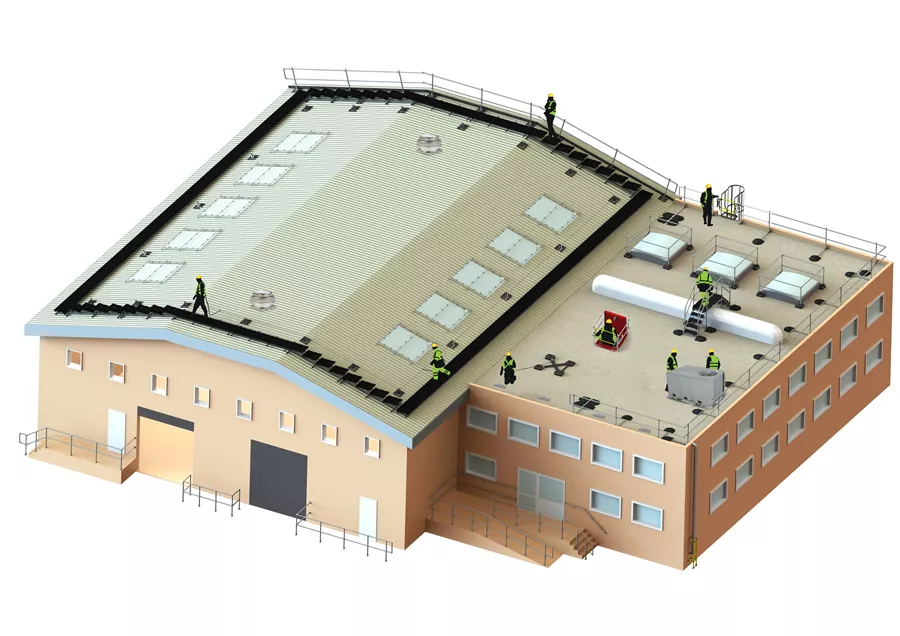
You are visiting the Canada Kee Safety website from United States. Would you like to go to the United States site?

Poet Gertrude Stein wrote, “A rose is a rose is a rose,” which echoed Shakespeare’s lines from Romeo and Juliet, “What’s in a name? That which we call a rose by any other name would smell as sweet.”
All roof anchor systems have the same purpose: to support workers at height using personal fall protection equipment (e.g., body harness, lanyard).
Regulations for roof anchor strength can vary between the federal, provincial, and territorial governments; however, several authorities agree that roof anchor strength should be 3.5 kilonewtons (800 lbs.) for temporary anchorages and 22 kilonewtons (5,000 lbs.) for permanent fixtures.
So, temporary and permanent—all roof anchors are not the same—and there are discrete differences within these classifications. Nevertheless, there is complete agreement that roof anchor fall protection and professional training are critical to help ensure the safety of construction, maintenance, and other workers operating at heights.

Rooftop workers using personal fall protection lifelines operate under work restraint or fall arrest systems.
Work restraint (also called travel or fall restraint) restrains workers from reaching a hazard, notably the roof edge, or falling to a lower level. The worker can operate freely within the span of the lifeline.
If the work must be performed at the leading edge of the roof (and no guardrail is present) or the working surface is fragile, a fall arrest system will not prevent a fall. It will stop the descent of the fall to the surface below. Fall arrest requires a rescue plan for the worker who falls.
Both fall protection systems require a compliant roof anchor, whether a work restraint or fall arrest anchor.

Permanent (fixed or rigid) roof anchors are installed into the roof—flat or sloped—or other part of the building’s structure. They are manufactured of robust, durable, and corrosion-resistant galvanized steel. Permanent anchors are designed for multiple roof types (e.g., BUR membrane systems, single-ply membranes, modified bitumen, green roofs, and metal roofs with underlying steel, concrete, or wood structures).
Depending on the roof or building, various connection types are available, including epoxy, shallow deck, cast-in, weld-on, wrap-around, bolted, screw-in, or a specialized BeamClamp. Attachment points can be tieback, single point, or horizontal lifeline.

Mobile roof deadweight anchors feature rubber-coated base weights that support a central pedestal with a tie-off. The components are constructed of galvanized steel and are easily assembled and disassembled for placement on a flat or low-sloped roof. The system does not penetrate the roof membrane and features more than 100 suction cups attached to every base weight for added friction and stability. Mobile anchors can have the same attachment types used on fixed anchors—forged or U-bar, single tie-off, and horizontal lifelines. It is recommended as a work restraint anchor system.
Mobile roof rope access anchors are used in a fall arrest system for a single user to access the façade of a building from the rooftop. It combines a mobile roof deadweight anchor with a strong strut assembly to form a compliant counterweight anchorage system. It is easy to set up, dissemble, and move along a flat or low-sloped roof.

Proper installation and use of roof anchors require specialized training to ensure that workers are fully competent and can work safely at heights.
Covers the essential principles of working safely at height, including risk assessment, equipment selection, and the proper use of fall protection systems. Participants learn how to identify hazards and implement safety measures to prevent accidents.
B) Anchor Bolt Installation & Testing
Provides hands-on training in the correct installation techniques, testing procedures, and compliance with relevant safety standards for anchor bolts to ensure their reliability.

The International Rope Access Trade Association (IRATA) was founded to provide a safe working environment when rope access is used for hard-to-reach or hazardous areas. There are three levels of IRATA-certified training courses:
Regardless of the differences between permanent and mobile roof anchors and distinctions among anchors, worker safety (by any other name) is worker safety.
Roof anchor fall protection ensures worker safety in elevated work environments. Combined with comprehensive certified training programs, it provides workers with the tools and knowledge they need to work safely at height.

Kee Safety Fall Protection Experts perform a critical analysis of the entire rooftop surface to identify the hazards where workers are exposed to the greatest risk. This ensures that the most dangerous areas are protected immediately with state-of-the-art fall protection systems and OH&S compliant solutions.